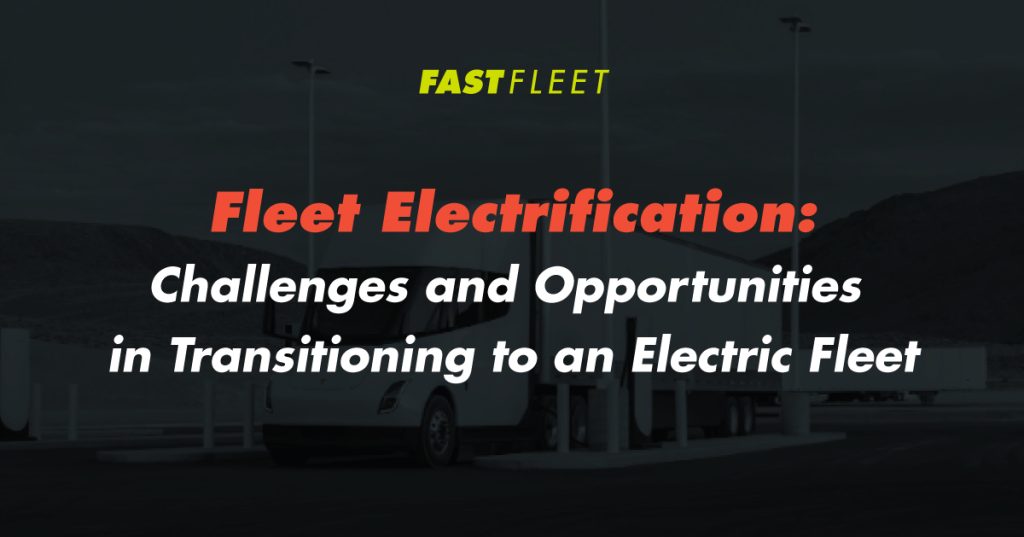The push towards fleet electrification is gaining momentum as businesses and governments recognize the environmental and economic benefits of transitioning to electric vehicles (EVs).
This shift promises significant reductions in greenhouse gas emissions and long-term cost savings. However, the journey to fleet electrification comes with its own set of challenges.
This blog will explore these challenges and highlight the opportunities associated with electrifying fleet operations.
Understanding Fleet Electrification
Fleet electrification involves replacing traditional internal combustion engine (ICE) vehicles with electric vehicles.
The primary benefits include lower emissions, reduced fuel costs, and decreased maintenance expenses.
Governments worldwide are encouraging this transition through regulations and incentives aimed at reducing the carbon footprint of transportation sectors.
Currently, the adoption of EVs in fleets is increasing, but it remains a developing market.
Early adopters are paving the way, benefiting from government incentives and contributing to sustainability goals.
Fleet Electrification Infrastructure Requirements
Charging Infrastructure: A robust charging infrastructure is critical for the successful adoption of EVs in fleets. There are three main types of charging stations:
- Level 1 Charging:
- Uses a standard 120-volt outlet.
- Suitable for overnight charging.
- Level 2 Charging:
- Uses a 240-volt outlet.
- Faster than Level 1 and ideal for workplace or public charging.
- DC Fast Charging:
- Provides rapid charging through a 480-volt system.
- Best for quick top-ups during long trips.
Challenges in establishing charging infrastructure include the high cost of installation, the need for sufficient space, and ensuring accessibility.
Collaboration with utility companies and government bodies can help mitigate these challenges by offering incentives and grants for infrastructure development.
Electric Grid Capacity: The increased adoption of EVs places additional demands on the electric grid. Managing this load requires strategic planning, including smart charging solutions that distribute the load during off-peak hours.
Utilities can offer incentives for off-peak charging to balance the grid demand and ensure reliability.
Cost Considerations For Fleet Electrification
Initial Investment: The upfront cost of EVs is typically higher than that of ICE vehicles. However, this initial investment can be offset by long-term savings in fuel and maintenance costs.
Additionally, government incentives and grants can significantly reduce the financial burden.
Total Cost of Ownership (TCO): When considering the TCO, EVs often prove more cost-effective than ICE vehicles. Key factors influencing TCO include:
- Fuel Savings: Electricity is generally cheaper than gasoline or diesel.
- Maintenance Costs: EVs have fewer moving parts and require less frequent maintenance.
- Vehicle Lifespan: EVs can have a longer operational life due to less wear and tear on the engine.
Government incentives, such as tax credits and rebates, can further reduce the TCO, making EVs an attractive option for fleet managers.
Government Incentives and Grants: Various incentives are available to encourage fleet electrification. These can include tax credits, rebates, and grants for purchasing EVs and installing charging infrastructure. Staying informed about available incentives can significantly impact the financial feasibility of transitioning to an electric fleet.
Environmental Impact
Reduction in Greenhouse Gas Emissions: Transitioning to an electric fleet significantly reduces greenhouse gas emissions. EVs produce zero tailpipe emissions, contributing to cleaner air and a lower carbon footprint.
This reduction aligns with global efforts to combat climate change and meet sustainability goals.
Sustainability Goals: Fleet electrification is a crucial step towards achieving corporate sustainability goals.
By reducing reliance on fossil fuels, businesses can demonstrate their commitment to environmental stewardship.
This commitment can enhance brand reputation and meet increasing consumer and regulatory demands for sustainable practices.
Battery Disposal and Recycling: While EVs offer environmental benefits, battery disposal and recycling present challenges. Batteries contain hazardous materials that require proper disposal to avoid environmental harm. Emerging technologies and practices aim to improve battery recycling, reducing the environmental impact and creating a circular economy for battery materials.
Operational Challenges and Solutions
Range Anxiety: One of the primary concerns for fleet managers is the limited range of EVs compared to ICE vehicles. Solutions to mitigate range anxiety include:
- Route Optimization: Planning routes to ensure efficient use of battery life.
- Strategic Charging Station Placement: Ensuring charging stations are available along routes.
- Advancements in Battery Technology: Ongoing research is improving battery capacity and charging speeds.
Driver Training and Adaptation: Transitioning to an electric fleet requires training drivers on the unique aspects of EV operation and maintenance. Training programs should cover:
- Efficient Driving Techniques: Maximizing battery life through smooth acceleration and braking.
- Charging Procedures: Proper use of charging infrastructure and managing charge times.
- Maintenance Practices: Understanding the different maintenance needs of EVs.
Maintenance and Repairs: EVs have different maintenance needs compared to ICE vehicles. Ensuring the availability of trained technicians and appropriate tools is crucial for effective fleet maintenance. Partnering with service providers specializing in EVs can help address this challenge.
Future Outlook
Technological Advancements: The future of fleet electrification looks promising, with continuous advancements expected in EV technology. Improvements in battery life, charging times, and vehicle efficiency will enhance the feasibility and attractiveness of EVs for fleet operations.
Market Trends: The market for electric fleets is expected to grow as more companies adopt EVs. As technology advances and economies of scale are realized, the costs of EVs and associated infrastructure are likely to decrease, making fleet electrification more accessible.
Fleet electrification presents both challenges and opportunities.
While the transition requires significant investment and planning, the long-term benefits of reduced emissions, lower operational costs, and alignment with sustainability goals make it a worthwhile endeavor.
By addressing infrastructure requirements, cost considerations, and operational challenges, fleet managers can successfully navigate the path to electrification.
Ensure a smooth transition to an electric fleet by partnering with Fast Fleet for reliable emergency roadside services.
Our expert team is ready to support your fleet with prompt and professional assistance, ensuring minimal downtime and maximum efficiency.
Contact Fast Fleet today to learn more about our comprehensive roadside services and how we can help you navigate the challenges of fleet electrification.
















